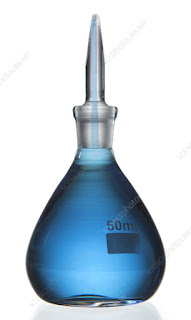Density
Remember that density is a measure of the amount of stuff packed into a space. Different liquids and different solutions will have different densities and determining the density of a solution can help identify the solution.
Mathematically, we use the formula \(d=\frac{mass}{volume}\). This means that to find the density of something, we need to know the mass and volume. There are several ways to do this for a liquid.
Finding Density of a Liquid
Direct Measurement The simplest way to do this is to measure the mass and volume directly in something like a graduated cylinder. First you would find the mass of the empty cylinder, then pour in an amount of the liquid and reweigh it. The difference in the two masses will be the mass of the liquid and the volume can be read directly from the cylinder. The density would be found using this equation: \(d=\frac{(mass~cylinder~and~liquid - mass~cylinder)}{volume~of~liquid}\) Although this method is quick and easy, it is limited by the imperfections of the measurements (the inherent error in mass measurement and the human error in volume measurement). Graphically with Repeated Measurement We can get past some of the limitations of direct measurement by making a series of measurements (mass and volume) and then graphing mass v. volume. Since density is an intrinsic quality (it doesn’t depend on amount), the data will give a straight line. Here is a series of data points graphed with and without the line of best fit.You can see that some of the points are above the line of best fit while some are below it. If we had relied on just one of those points, our density value could be quite a bit off, but using the line “smooths” out those inconsistencies.
Because slope is \(\frac{''rise''}{''run''}\) then in this case, slope will be \(\frac{mass}{volume}\) which is, of course, density.
Pycnometer
Another way to find the density of a liquid is to use a device known as a pycnometer. A pycnometer is simply a container with a known and constant volume. The picture to the right is a commercially produced pycnometer.
When we measure density directly, the weakest part of the process is the human error associated with measuring the volume of liquid in a graduated cylinder. Pycnometers eliminate this error. Because pycnometers are calibrated, the volume measurement can be as reliable as the mass measurement on a good balance, thus providing a more reliable density value.
Of course, pycnometers serve no other purpose, which means that unless a lab is making regular density measurements it is unlikely that such a device will be available.





No comments:
Post a Comment